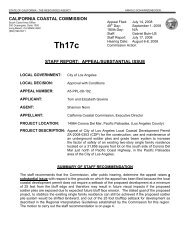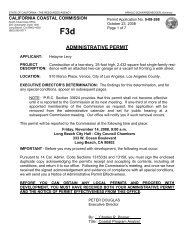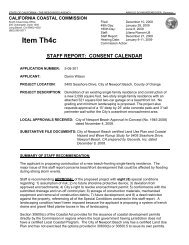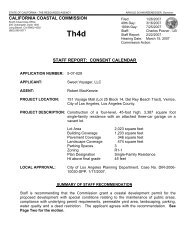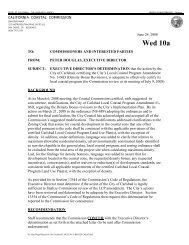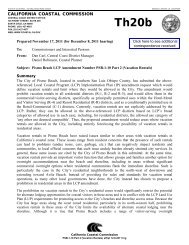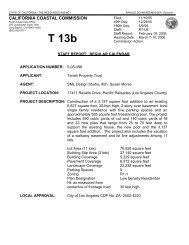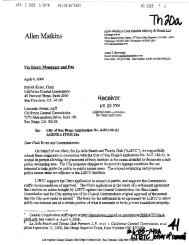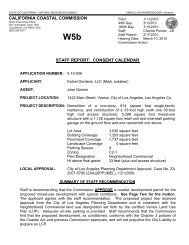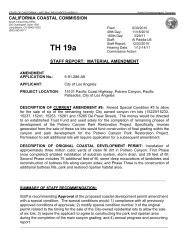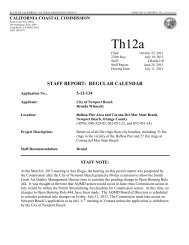Consent Cease and Desist Order No. CCC-13 - State of California
Consent Cease and Desist Order No. CCC-13 - State of California
Consent Cease and Desist Order No. CCC-13 - State of California
You also want an ePaper? Increase the reach of your titles
YUMPU automatically turns print PDFs into web optimized ePapers that Google loves.
<strong>CCC</strong>-<strong>13</strong>-CD-02 & <strong>CCC</strong>-<strong>13</strong>-RO-02 (Caribbean)<br />
vegetation buffer areas that protect riparian habitats, <strong>and</strong> minimize alteration <strong>of</strong><br />
natural streams. (Coastal Act/ 30231).<br />
The unpermitted development performed here involves extensive vegetation removal,<br />
thus exposing bare soil, increasing the site’s susceptibility to erosion; grading; <strong>and</strong><br />
importation <strong>of</strong> dirt. The unpermitted development was undertaken <strong>and</strong> maintained during<br />
multiple rainy seasons without adequate best management practices for controlling run<strong>of</strong>f<br />
<strong>and</strong> sediment discharge that are necessary to protect water quality.<br />
The vegetation that existed on the subject property prior to the unpermitted development<br />
helped to stabilize the soil, limit run<strong>of</strong>f <strong>and</strong> erosion, <strong>and</strong> facilitated infiltration. The<br />
removal <strong>of</strong> that vegetation, especially in the absence <strong>of</strong> adequate best management<br />
practices, has exposed the site <strong>and</strong> surrounding properties <strong>and</strong> water bodies to the effects<br />
<strong>of</strong> unregulated run<strong>of</strong>f. Unmanaged run<strong>of</strong>f across exposed dirt areas increases the level <strong>of</strong><br />
sediment entering water bodies, consequently also increasing the turbidity <strong>of</strong> receiving<br />
waters, which reduces the penetration <strong>of</strong> sunlight needed by aquatic vegetation that<br />
provides food <strong>and</strong> cover for aquatic species <strong>and</strong> disrupts the reproductive cycles <strong>of</strong><br />
aquatic species, leading to adverse changes in reproduction <strong>and</strong> feeding behavior. These<br />
impacts reduce the biological productivity <strong>and</strong> the quality <strong>of</strong> coastal waters <strong>and</strong> reduce<br />
optimum populations <strong>of</strong> marine organisms. Similarly, sediment-laden stormwater run<strong>of</strong>f<br />
can increase sedimentation in coastal waters. Sedimentation <strong>of</strong> coastal waters impacts<br />
fish populations in part by burying aquatic vegetation that provides food <strong>and</strong> cover for<br />
aquatic species. For these reasons, the unpermitted development is inconsistent with<br />
Coastal Act Section 30231.<br />
c. Minimization <strong>of</strong> Adverse Impacts <strong>and</strong> Natural L<strong>and</strong>form Alteration<br />
The unpermitted development is inconsistent with Section 30253(b) <strong>of</strong> the Coastal Act,<br />
which requires new development to minimize erosion <strong>and</strong> associated impacts to the site.<br />
Section 30253(b) states:<br />
New development shall... (b) Assure stability <strong>and</strong> structural integrity, <strong>and</strong> neither<br />
create nor contribute significantly to erosion, geologic instability, or destruction <strong>of</strong> the<br />
site or surrounding area or in any way require the construction <strong>of</strong> protective devices that<br />
would substantially alter natural l<strong>and</strong>forms along bluffs <strong>and</strong> cliffs.<br />
In addition, the City LCP contains the following policies:<br />
Conservation Open Space Element Policy 2.9: Preserve significant natural<br />
features as part <strong>of</strong> new development. Permitted development shall be sited <strong>and</strong><br />
designed to minimize the alteration <strong>of</strong> natural l<strong>and</strong>forms. Improvements adjacent<br />
to beaches shall protect existing natural features <strong>and</strong> be carefully integrated with<br />
l<strong>and</strong>forms. (Coastal Act/30240, 30250, 30251, 30253)<br />
Conservation Open Space Element Policy 2.<strong>13</strong>: Bluff repair <strong>and</strong> erosion control<br />
measures such as retaining walls <strong>and</strong> other similar devices shall be limited to<br />
18



